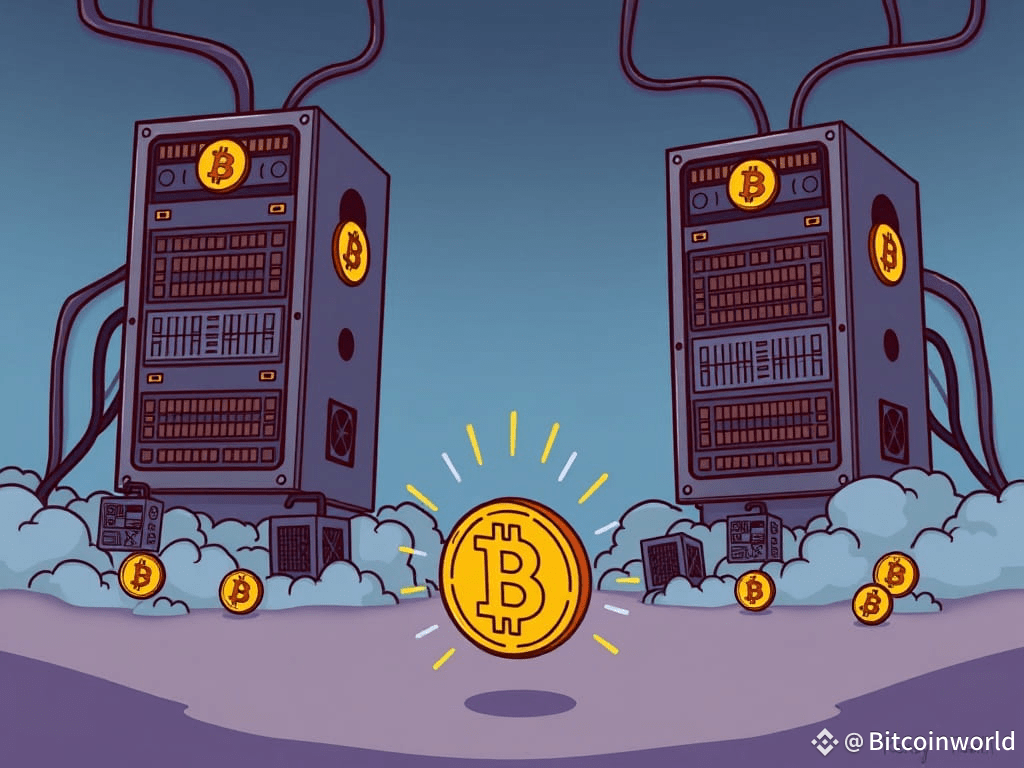BitcoinWorld  Bitcoin Hashrate: Urgent Concerns Emerge as Two Pools Dominate 51%
Bitcoin Hashrate: Urgent Concerns Emerge as Two Pools Dominate 51%
Recent reports from WhaleWire on X have sent ripples through the cryptocurrency community, highlighting a significant development in the world of Bitcoin. For the first time in over a decade, just two Bitcoin mining pools now collectively command more than 51% of the network’s total Bitcoin hashrate. This concentration of power immediately sparks urgent discussions about the foundational security and decentralized nature of the network.
Understanding the 51% Attack and its Impact on Bitcoin Hashrate
What exactly does this concentration mean? When a single entity or a colluding group controls over 50% of a blockchain network’s computational power, known as its Bitcoin hashrate, they theoretically gain the ability to manipulate the network. This scenario is widely referred to as a “51% attack.”
Such an attack on the Bitcoin network could have severe consequences:
Double-Spending: An attacker could spend their bitcoins, then reverse the transaction on the blockchain, effectively spending the same coins twice.
Transaction Censorship: They could prevent specific transactions from being confirmed, effectively blocking users or services.
Chain Reorganization: An attacker might reverse recent transactions, potentially disrupting the integrity of the ledger.
While theoretical, the mere possibility raises legitimate concerns among investors and enthusiasts alike regarding the robustness of Bitcoin’s security model.
Why is This Bitcoin Hashrate Concentration So Alarming?
Bitcoin was designed with decentralization as a core principle. Its creator, Satoshi Nakamoto, envisioned a network where no single entity held undue influence, ensuring trustless transactions and resistance to censorship. The distribution of Bitcoin hashrate across numerous independent miners and pools is crucial for maintaining this ideal.
The last time such a significant concentration was observed was over ten years ago, a period when the network was much smaller and less mature. Today, with Bitcoin’s global adoption and market capitalization, any perceived vulnerability is magnified. This recent development challenges the long-held belief in Bitcoin’s impenetrable security due to its distributed mining power.
How Does the Community Respond to Concentrated Bitcoin Hashrate?
The cryptocurrency community is highly vigilant about any signs of centralization. News of concentrated Bitcoin hashrate typically triggers immediate debate and analysis. While a 51% attack is technically feasible, executing one successfully and sustainably is incredibly difficult and economically counterproductive for the attackers.
Consider these factors:
Economic Disincentive: An attacker would likely damage Bitcoin’s value, devaluing their own holdings and the reward for the attack itself.
Community Resistance: The community could coordinate a soft fork or hard fork to nullify the attack or alter the mining algorithm, rendering the attacker’s specialized hardware useless.
Dynamic Hashrate: Mining power can shift rapidly. If a pool gains too much power, other miners might choose to switch pools to re-decentralize the network.
These inherent mechanisms act as deterrents, but the current situation serves as a stark reminder of the ongoing need for vigilance and diversified mining participation.
What’s Next for Bitcoin Hashrate and Network Security?
The recent concentration of Bitcoin hashrate underscores the importance of a healthy, distributed mining ecosystem. While the network has proven resilient over time, continuous monitoring and proactive measures are essential. It encourages individual miners and smaller pools to remain active and competitive, ensuring a broader distribution of power.
For the long-term health of Bitcoin, it is vital that the mining landscape remains competitive and diversified. This recent report is a wake-up call, reminding us that decentralization is not a static state but an ongoing effort requiring community participation and awareness. The strength of Bitcoin truly lies in its distributed nature, a principle that must be continuously upheld.
The news that two mining pools now control over 51% of the Bitcoin hashrate is indeed a significant development, prompting serious discussions about network security. While the theoretical risk of a 51% attack exists, Bitcoin’s robust design, economic disincentives, and a vigilant community provide strong countermeasures. This event serves as a crucial reminder for the ecosystem to remain committed to decentralization, ensuring the long-term integrity and resilience of the world’s leading cryptocurrency.
Frequently Asked Questions (FAQs)
Q1: What is Bitcoin hashrate?
A1: Bitcoin hashrate refers to the total combined computational power being used to mine and process transactions on the Bitcoin network. A higher hashrate generally indicates greater network security.
Q2: What is a 51% attack?
A2: A 51% attack occurs when a single entity or group gains control of more than 50% of a blockchain network’s mining power (hashrate). This control could allow them to manipulate transactions, such as double-spending or censoring transactions.
Q3: Has a 51% attack ever successfully occurred on Bitcoin?
A3: While theoretical, a successful and sustained 51% attack on the Bitcoin mainnet has never occurred. The network’s economic incentives and community vigilance make such an attack extremely difficult and costly to execute.
Q4: Why are mining pools a concern for decentralization?
A4: Mining pools allow individual miners to combine their computational power, increasing their chances of solving blocks and earning rewards. However, if a few large pools accumulate a significant majority of the network’s hashrate, it can lead to centralization concerns, as seen with the current Bitcoin hashrate distribution.
Q5: What can be done to prevent hashrate concentration?
A5: Encouraging individual miners to join smaller, more diverse pools, promoting the development of new mining technologies, and fostering awareness within the community about the importance of decentralization are key steps to prevent excessive hashrate concentration.
If you found this article insightful, please share it with your network on social media to help raise awareness about the critical topic of Bitcoin hashrate distribution and network security. Your support helps strengthen the decentralized future of cryptocurrency!
To learn more about the latest Bitcoin trends, explore our article on key developments shaping Bitcoin’s network security and decentralization efforts.
This post Bitcoin Hashrate: Urgent Concerns Emerge as Two Pools Dominate 51% first appeared on BitcoinWorld and is written by Editorial Team


